

Integrando las TIC en Educación... hoy (versión 2.0) Introducción: tenemos un grave problema Tenemos un grave problema.

En gran medida, estamos preparando a nuestros estudiantes para una sociedad que ya no existe. Quizás por ello estamos entre los países de la Unión Europea con mayor fracaso escolar y con mayor paro juvenil, al tiempo en que también nos situamos a la cola de los países de la OCDE en rendimiento académico (según las pruebas PISA). Y es que estamos haciendo muchas cosas mal. Hemos parcheado nuestro enciclopédico currículum tradicional con los añadidos de las "competencias", en vez de elaborar un nuevo currículum acorde a los requerimientos de nuestros tiempos. Esto no puede seguir así. En este contexto, iniciamos aquí la publicación de unas "hojas de ruta" que pretenden orientar la toma de decisiones hacia la mejora de la Educación. Hoja de ruta (1): Integrando las TIC en Educación ETAPA-1: Primeras actuaciones a realizar. 1.- Pizarra digital en TODAS las aulas de clase.
Modelo "currículum bimodal" (Pere Marquès) Laboratorio Internacional de Partículas Elementales. Laboratorio Internacional de Partículas Elementales. El Laboratorio de Partículas Elementales, Departamento de Física, ubicado en la División de Ciencias e Ingenierías, Campus León de la Universidad surgió el año 2005, por iniciativa del Dr.
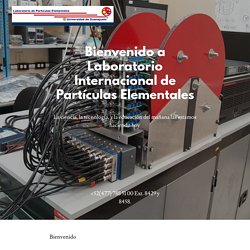
Julián Félix. Indicadores – RICYT. (2) Conferencia Olivia Levrini. Formas de participación en Ciencia Ciudadana. Por Diego Torres y Alejandro Fernandez – LIFIA, Facultad de Informática, UNLP.

En el artículo anterior introdujimos el concepto de ciencia ciudadana y, de alguna manera, dimos cuenta del potencial de esta forma de hacer ciencia. Un proyecto de ciencia ciudadana puede surgir de la necesidad de un grupo de científicos, que define tareas a ser resueltas por voluntarios y las delega. También puede originarse en la iniciativa autogestionada de los voluntarios. En este artículo, presentamos la tipología de Wiggins y Crowston[1] de proyectos de ciencia ciudadana, que hace foco en la forma de participación de los ciudadanos.
De acuerdo a dicha topología, los proyectos de ciencia ciudadana pueden ser de Acción, Conservación, Recolección (Investigación), Virtuales o de Docencia. Proyectos de Acción: Los proyectos de ciencia ciudadana orientados a la acción motivan la intervención en preocupaciones locales, utilizando la investigación científica para dar soporte a las agendas civiles. Ciencia ciudadana: el conocimiento al alcance de todos. Ciencia ciudadana.
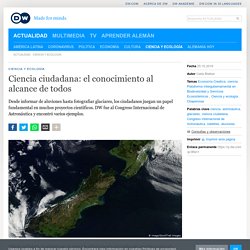
Lo primero que se viene a la cabeza cuando se escucha este concepto es algo así como contar insectos o aves durante un paseo. Pero en el Congreso Internacional de Astronáutica que se realiza en Washington (Estados Unidos), jóvenes científicos presentaron ejemplos del uso que se hace de la ciencia ciudadana en un campo muy complejo: la observación de la Tierra. En el plenario "próxima generación", realizado el jueves (24.10.2019), cinco investigadores emergentes dieron a conocer proyectos que incluían imágenes satelitales y aportes de personas comunes y corrientes. El encuentro, titulado "Aprovechamiento de la ciencia ciudadana en el futuro de la observación de la Tierra”, fue uno de los siete paneles de discusión, 33 conferencias magistrales y más de 1.900 presentaciones realizadas por investigadores y representantes corporativos en el congreso.
Observar glaciares y ayudar a la ciencia hoy es posible. Ayudar a la NASA Fotos turísticas e imágenes satelitales. ¿Qué es la ciencia ciudadana y cómo promueve el conocimiento abierto? - Abierto al Público. (26) Clase 2 Aprendizaje Presentación 3. (26) Clase 2 Aprendizaje Presentación 2. (26) Clase 2 Aprendizaje Presentación 1. PhysicsEducation.net: Current Projects. Scientific Abilities. Instructor site access: If you are an educator and would like access to additional instructor resources you can request it by email.
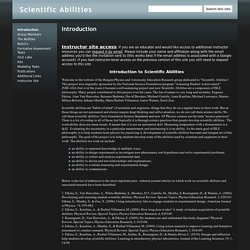
Please include your name and affiliation along with the email address you'd like the invitation sent to (this works best if the email address is associated with a Google account). Departamento de Didáctica de las Ciencias Experimentales y Sociales. Visible Thinking. Modeling Instruction Program. Study shows that students learn more when taking part in classrooms that employ active-learning strategies. Co-author Kestin, who in addition to being a physicist is a video producer with PBS’ NOVA, said, “It can be tempting to engage the class simply by folding lectures into a compelling ‘story,’ especially when that’s what students seem to like.
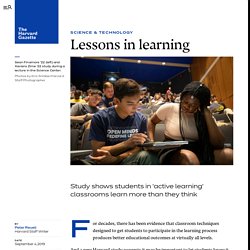
I show my students the data from this study on the first day of class to help them appreciate the importance of their own involvement in active learning.” McCarty, who oversees curricular efforts across the sciences, hopes this study will encourage more of his colleagues to embrace active learning. “We want to make sure that other instructors are thinking hard about the way they’re teaching,” he said. PhysPort: Supporting physics teaching with research-based resources. Convocatorias Educativas. Multimedia. Erik Mazur, confesiones de un profesor convertido (al modelo inverso) , inventor del peer instruction y precursor del flipped learning.
Dado el gran éxito que ha tenido la reciente entrada sobre las ideas de Eric Mazur sobre evaluación del aprendizaje, he decidido reeditar esta vieja entrada sobre Eric Mazur para celebrar las 485.000 visitas al blog profesor 3.0.
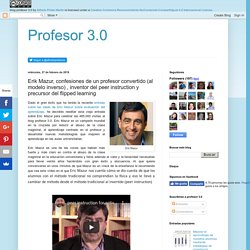
Science Education. PhysPort: Supporting physics teaching with research-based resources. Department of Physics Cornell Arts & Sciences. MIT Teaching and Learning Laboratory. Watch Active Learning in Action at MIT Guideline: Actively engage students in the learning process.

The data suggest that STEM instructors may begin to question the continued use of traditional lecturing in everyday practice, especially in light of recent work indicating that active learning confers disproportionate benefits for STEM students from disadvantaged backgrounds and for female students in male-dominated fields. Freeman, S., Eddy, S. L., McDonough, M., Smith, M. K., Okoroafor, N., Jordt, H., & Wenderoth, M. Definition of Flipped Learning. Released March 12, 2014 To counter common misconceptions and bring clarity to discussions about “Flipped Learning,” the governing board and key leaders of the Flipped Learning Network (FLN) announced a formal definition of the term. They also released the Four Pillars of F-L-I-P™ and a checklist of eleven indicators that educators must incorporate into their practice.
The group of experienced flipped educators also draws a distinction between Flipped Learning and a Flipped Classroom. While often defined simplistically as “school work at home and home work at school,” Flipped Learning is an approach that allows teachers to implement a methodology, or various methodologies, in their classrooms.
Robert Talbert, Ph.D. Overview of Action Research Methodology. “If you want it done right, you may as well do it yourself.”
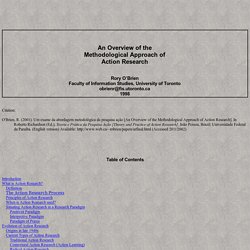
This aphorism may seem appropriate if you are a picky housekeeper, but more and more people are beginning to realize it can also apply to large corporations, community development projects, and even national governments. Such entities exist increasingly in an interdependent world, and are relying on Action Research as a means of coming to grips with their constantly changing and turbulent environments.
This paper will answer the question “What is Action Research?” , giving an overview of its processes and principles, stating when it is appropriate to use, and situating it within a praxis research paradigm. The evolution of the approach will be described, including the various kinds of action research being used today. Physics Lab Inventory of Critical thinking. The Physics Lab Inventory of Critical thinking (PLIC) is a closed-response survey designed to assess how students critically evaluate experimental methods, data, and models.
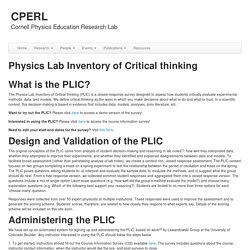
We define critical thinking as the ways in which you make decisions about what to do and what to trust. In a scientific context, this decision-making is based in evidence that includes data, models, analyses, prior literature, etc. Critical Thinking—Attained through Physics. Ministerio de Educación Pública. UMaine PERL: Mechanics.
Katrina E. Black Multiple Perspectives on Student Solution Methods for Air Resistance Problems. I modelli fisici ed il processo di modellizzazione. Un modelo de modelo científico para la enseñanza de las ciencias naturales. Eric Mazur después de revolucionar la enseñanza pasa a revolucionar la evaluación. THE BIG NEWS – Flipped Learning Global Initiative. Jon Bergmann Jon Bergmann is one of the pioneers of the Flipped Classroom Movement. He is leading the worldwide adoption of flipped learning through the Flipped Learning Global Initiative (FLGI) flglobal.org. He is working with governments, schools, corporations, and education non-profits.
Jon has coordinated and guided flipped learning projects around the globe. Locations include: China, Taiwan, Korea, Australia, the Middle East, Iceland, Sweden, Norway, the United Kingdom, Italy, Spain, Mexico, Canada, South America, and the United States.Jon is the author of nine books including the bestselling book: Flip Your Classroom which has been translated into 13 languages.
Gamification of Quantum Mechanics Teaching. Everyone's library. Your IP has been blocked. Transforming physics educator identities: TAs help TAs become teaching professionals: American Journal of Physics: Vol 85, No 5. Evidence of impact: Transforming teacher education with preparing tomorrow's teachers to teach with technology (PT3) grants. JavaScript is disabled on your browser. Please enable JavaScript to use all the features on this page. Abstract This article uses the framework of technological pedagogical content knowledge (TPACK; Mishra & Koehler, 2006) to analyze findings across projects from the U.S. Department of Education's Preparing Tomorrow's Teachers to Use Technology (PT3) initiative. Approaches such as mentoring methods course faculty, teachers, and creating technology-rich instructional materials were associated with increases in preservice teachers' technological knowledge and their frequency of technology-rich instruction during field experiences.
Physical Review Physics Education Research - Recent Articles. Home - Faculty of Education. Essential Readings in Problem-based Learning. Glosario de Innovación Educativa. Sabemos que la labor docente va más allá de las actividades que se llevan a cabo en el aula. Los profesores normalmente tienen un sinfín de actividades que realizar antes y después de clase, desde preparar el material para sus alumnos, revisión de exámenes y tareas, juntas académicas y administrativas, atención a padres, sesiones de asesoría y un largo etcétera. Todo esto, sin contar la necesaria preparación y formación profesional que todos deben llevar para responder a los nuevos retos que se presentan en el sector educativo. Hoy en día, existen numerosas opciones, presenciales y en línea, donde los docentes pueden prepararse y actualizarse continuamente.
Sin embargo, mucha de la literatura que encontramos en libros, publicaciones y cursos en línea, están llenos de términos que si bien se utilizan frecuentemente, muchas veces se desconoce el significado. Physical Review Physics Education Research - Recent Articles. News, Videos, and Podcasts – American Modeling Teachers Association.
Where are AMTA members? A short video representation of AMTA worldwide membership. A Modeling Approach to Physics Instruction.